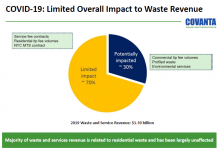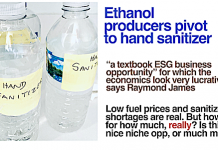Last week ethanol producer Green Plains (GPRE: Nasdaq) reported financial results for the quarter ending June 2018. As expected the company reported a net loss, but actual results were far better than expected. The news gave traders a reason to celebrate with bids that led to a gap higher at the opening on the first day of trading following the announcement. Cooler heads came into the market as the day wore on and the stock closed below the open on heavy volume. Nonetheless, the stock finished the week higher and appears prepared to challenge lines of volume-related price resistance in the trading sessions ahead.
There may have been more in the quarter report than just earnings news. Management just disclosed the acquisition of a cattle-feeding operation. Yes, that is right. Green Plains has become a beef producer!

Crush on Corn
The ethanol industry hangs on the ‘ethanol crush spread,’ which is a sexy way of referring to the gross production margin for the business. The margin is computed as the difference between the combined sales value of ethanol plus distiller’s grain by-products and the cost of corn. The difference is the stuff of much speculation in the ethanol industry and provides the profits, if there are to be any, in an ethanol operation.
Unfortunately, of late with current production practices margins on ethanol have been weak. The story can be illustrated simply with Green Plains own reported gross margin. Just four years ago, Green Plains recorded gross profit margins in the low double digits. In the year 2014, the reported gross margin was 12.9%. Fast forward to the year 2017, the gross margin had fallen to 7.3%. The downward trend continued in the first half of 2018, with the gross margins sinking to 5.8%.
Pulling Profit Levers
There are several levers that management of any company can pull to boost profit margins. First thought is usually to increase prices and thereby build margins with higher revenue. Unfortunately, ethanol is a commodity and its producers end up as price takers. A higher price tag would likely kill sales.
A second brilliant idea is to find new markets and new customers with potentially a more favorable demand profile. Exports of U.S. ethanol have been rising gradually over the past decade with China figuring prominently among customers. Exports reached a monthly peak in February 2018, at 5.3 million barrels, but have come down by 50% since the Trump Administration’s trade war with China heated up. The export channel is for the time being not a solution to profit margin issues.
Of course, the ethanol crush spread could be improved by sourcing corn at lower prices. Unfortunately, there is again that pesky commodity market dynamic that frustrates side deals and price undercutting. Production efficiencies delivered by new technology or access to lower cost distribution transport also show promise.
Earlier this year Green Plains invested in technology to produce high-protein feed ingredients. Sometime mid-2018, the company’s ethanol plant in Shanandoah, Iowa will commission a MSC Protein System from Fluid Quip Process Technologies. Some of the distillers’ grains will be diverted to this process to produce higher value high-protein animal and fish feed ingredients. Management estimates a dime could be added to its ethanol crush spread.
Feeding Cattle
A dime is impressive, but Green Plains management has an entirely different lever in their grip that might deliver more than dimes. They have chosen to not only look for new markets, but to diversify their product line entirely by integrating forward into a beef production. The day before the earnings announcement the company disclosed it has agreed to acquire two cattle-feed operations from Bartlett Cattle Company for $16.0 million.
This is not a really a new strategy for Green Plains. The company first started investing in food production in 2014, with the acquisition of feedlot and grain storage facilities in Kismet, Kansas. That feedlot had capacity for 70,000 head of cattle. Since then Green Plains has made a series of small acquisitions that has increased feedlot capacity to 260,000 by the end of December 2017. The latest deal is for the largest single operation that Green Plains has acquired so far, boosting capacity by more than one third to 355,000 head.
With this last deal Green Plains seems more like a serious player in the beef production supply chain. Owning sizable feedlot operations gives the Company a meaningful internal source of demand for its distillers’ grains, corn oils and high-protein feed ingredients by-products of the ethanol process. By integrating forward Green Plains captures the value created by those feed products in the cattle operations.
Green Plains management promised that the newly acquired feedlot operations will be immediately accretive to earnings. Just three months from now when the company repots financial results for the quarter ending September 2018, investors can expect to see the impact from the deal. Since it will only be a two-month contribution, it may be too early to observe the contribution to profit margins from the increase in internal feed sourcing.
The company is paying for the deal in part with a $75 million increase in its revolving credit facility. An agent approval can add make another $100 million available to Green Plains for working capital.
Industry Shakeout
With Trump’s trade war against China frustrating an already difficult profit margin situation for ethanol producers, the industry appears poised for some sort of shake out. Smaller producers with limited access to capital markets may find it difficult to invest in technology for efficiencies or make diversifying investments. We expect another wave of consolidation in the industry. Green Plains may be in the market….or not. Management has made clear its strategy is to stay true to its ethanol roots except when forward or backward integration makes sense.
Debra Fiakas is the Managing Director of Crystal Equity Research, an alternative research resource on small capitalization companies in selected industries. Neither the author of the Small Cap Strategist web log, Crystal Equity Research nor its affiliates have a beneficial interest in the companies mentioned herein.








